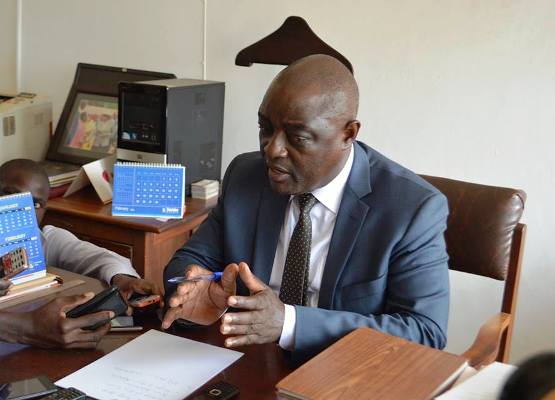The Ministry of Agriculture, Animal Industry and Fisheries in Uganda (MAAIF) has given an update on the locust invasion in the country together with the Food and Agriculture Organization of the United Nations. The following is an excerpt of the update by Mr. Pius Wakabi Kasajja the Permanent Secretary.

Five weeks ago, Uganda was invaded by Desert Locusts from neighboring Kenya through Amudat and to-date 24 districts in the 6 sub-regions of Acholi, Karamoja, Lango, Sebei, Teso and Bugisu have reported these locust swarms.
Uganda has so far recorded the entry of 9 swarms of mature Desert locusts. These swarms have not caused significant damage to the vegetation cover. The eminent danger to food security and livelihoods however will likely be posed by the nymphs and young desert locusts that will hatch. These nymphs and young desert locusts have a high need for food consuming close to 100 tons of vegetation per day depending on the size of the swarm.
A swarm spreading about 6 square
kilometres was observed on 12th Match 2020 in Masike, Kangole Town Council near
Kangole Girls Primary School in Karamoja sub-region. Control measures
undertaken by the Uganda People’s Defence Forces (UPDF), however, suppressed
the swarm.
Technical Surveillance teams in the region continue to receive reports of Desert Locust hatching in Agago, Ngora, Sironko and Bukwo. However, upon visiting the sites by technical teams, the presence of Variegated Grass hoppers was confirmed and not locusts. Other reports of hatching in Amudat and Nakapiripirit have been proved to be false by the surveillance team. No hatching of the Desert Locust eggs has been observed yet in the country as of 13th March 2020.
This week, the Ministry of Agriculture, Animal Industry and Fisheries is
training an additional 100 Agricultural Extension Officers in addition to 450
already trained from Karamoja and Teso sub-regions. These officers are being
trained on desert locust identification, behaviour, management and Control. This
is intended to build capacity of the key stakeholders in management and control
of the pest targeting teams not previously trained.
The Desert Locust
Control Organisation for Eastern Africa (DLCO-EA) aircraft
is still in Lodwar, Turkana Kenya for trans-boundary control while at the same
time ready for relocation to Uganda to control the swarms that may warrant
aerial spraying.
The Ugandan government through the ministry of Agriculture Animal Industry and
Fisheries has fast tracked the procurement of appropriate equipment and
chemicals. On 11th March 2020, another 1000 litres of Fenitrothion 96% ULV was
received from Twiga Chemicals – Kenya. The total Amount of Fenitrothion 96% ULV
is so far 1400 litres out of 10000 litres that was ordered. 18000 litres of
Emulsifiable Concentrate (EC) for ground spraying was procured and 2000 sets of
personal protective gear and these are being used by field teams.
The government has so far procured and dispatched 500 motorized spray pumps and
2000 Knapsack spray pumps with an assortment of Protective Equipment. Ground
control operations have been conducted in all the 24 districts to minimize the
spread of mature egg laying desert locusts. The government has so far mobilized
UGX 22 Billion from its treasury and various development partners have come on
board to facilitate implementation of Desert Locust Control plan.
Eleven Billion Uganda Shillings (UGX 11.1 billion) was paid as the arrears to
Desert Locust Control Organization (DLCO-EA). UGX 2.8 Billion was spent on
aerial spraying pesticides, 1.2 billion was spent on pumps, and UGX 1.39
Billion was paid for UPDF operations while 1.2 Billion on operational expenses.
3.6 Billion has been committed for Aircraft operations and UGX 0.71 Billion is
the current balance being used on current activities.
An additional UGX 16.18 Billion is being mobilized from the treasury to enhance
UPDF and Desert Locust Control activities; support district local governments
control efforts and to intensify sensitisation and awareness creation,
surveillance and mapping activities.
MAAIF technical teams with support of the National consultant and in collaboration with experts from Desert Locusts Control Organisation for Eastern Africa (DLCOEA), Food and Agricultural organisation (FAO) and National Agriculture Research Organisation (NARO) have continued to build capacity of the UPDF, Extension Workers, Uganda Wild Life Authority staff and District Local Government. To-date 2,045 UPDF soldiers, 85 UWA staff, 385 Extension workers and 450 other district local government staff have been trained and deployed.
Support has been received from both UN agencies and other Development Partners
during implementation of the Desert Locust control interventions.
Under the tenets of a Technical Cooperation Project, FAO is supporting Desert Locust Control activities to the tune of US$500,000 and through regional efforts will further enhance this support. FAO continues to provide expertise helpful in Desert Locust control activities. In addition, FAO has donated 4 double cabin vehicles with vehicle mounted spray equipment, 10 motorized sprayers, 10 knapsack sprayers, 100 assorted protective gear including; helmets, overalls, safety googles, gumboots all for demonstration purposes.
World Food program provided 5 (five) fully serviced trucks which are being used for logistics in the control operations. They have also provided a number of mobile stores for the equipment in the field.
The Government of Bulgaria has the Republic of Uganda an Air craft to support
aerial control activities through spraying. The Government of Uganda will be
responsible for the supply of chemicals, fuel and accommodation for the crew.
It is currently being configured to locust spraying before it is brought into
the Country.
Others Partners include African Development Bank, World Bank, Bill Gates and
Melinda Foundation who have equally promised support.
Challenges
Specialized pesticide formulation for aerial spraying (Fenitrothion 96% ULV) is a challenge to obtain due to the current wave of desert locust outbreak in the Horn of Africa, Middle East and the Eastern Africa Region.
In addition to the shortage of the recommended aerial spraying pesticide, the nose masks (N95) are hard to find as there is stiff competition with Corona virus. Suppliers have said that the Chinese have been buying these masks from Uganda due to shortages in their country.
There is also challenge of Desert Locusts invasion into Kidepo Valley National Park. MAAIF is engaging Uganda Wildlife Authority to support mapping out of possible settlement of desert locusts to prepare for spot control.
Uganda still continues to experience further invasions from Kenya. Some of
those areas in Kenya previously invaded have newly hatched hoppers. MAAIF will
continue to engage the Kenyan Government on joint operations for ground
spraying to ensure that the newly hatched hoppers do not reach maturity and
move into Uganda.
MAAIF appeals to the general public to prepare to plant crops for the season A,
2020 since the government has put in place measures to ensure that the crops
will be protected from the Desert Locust












